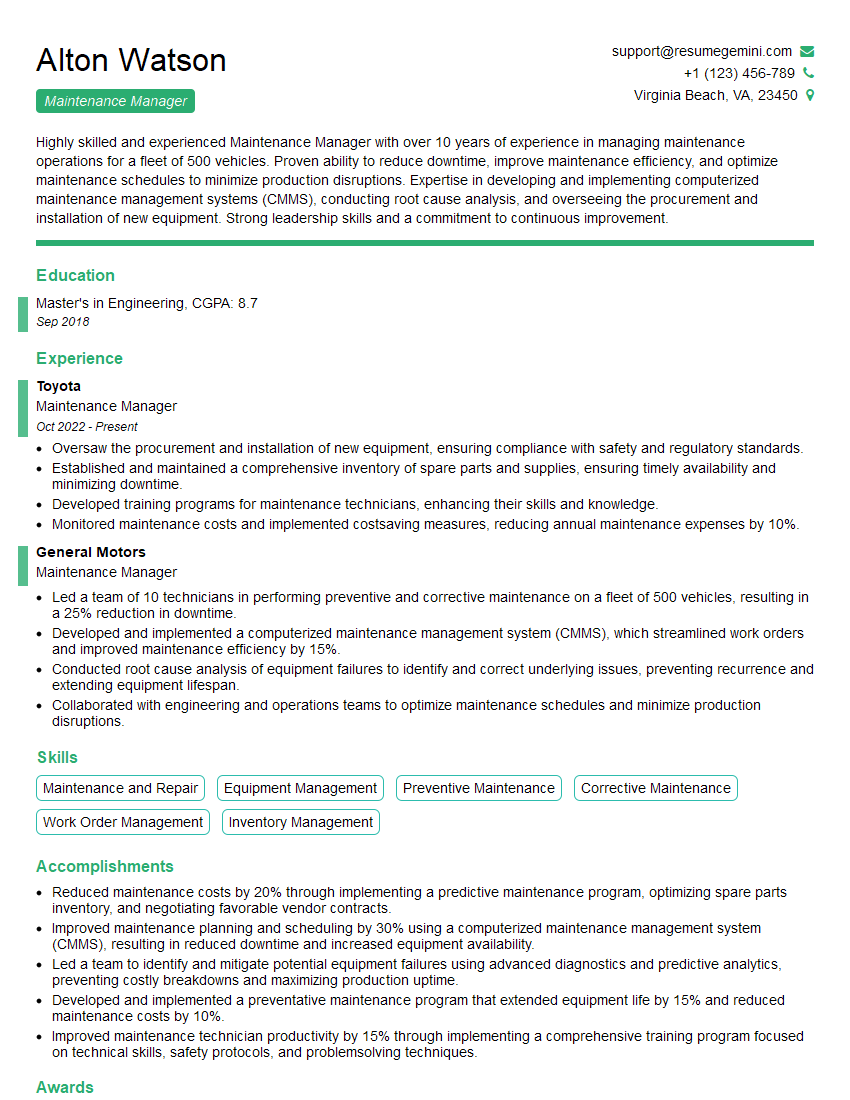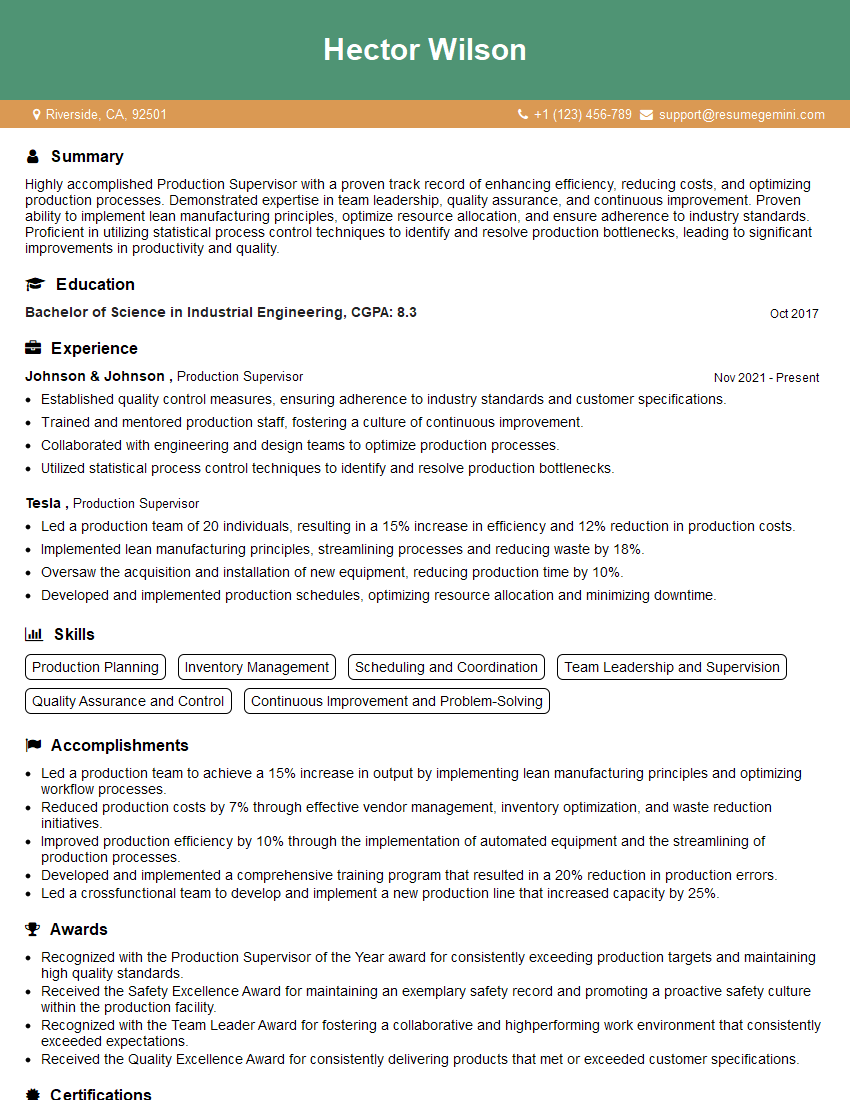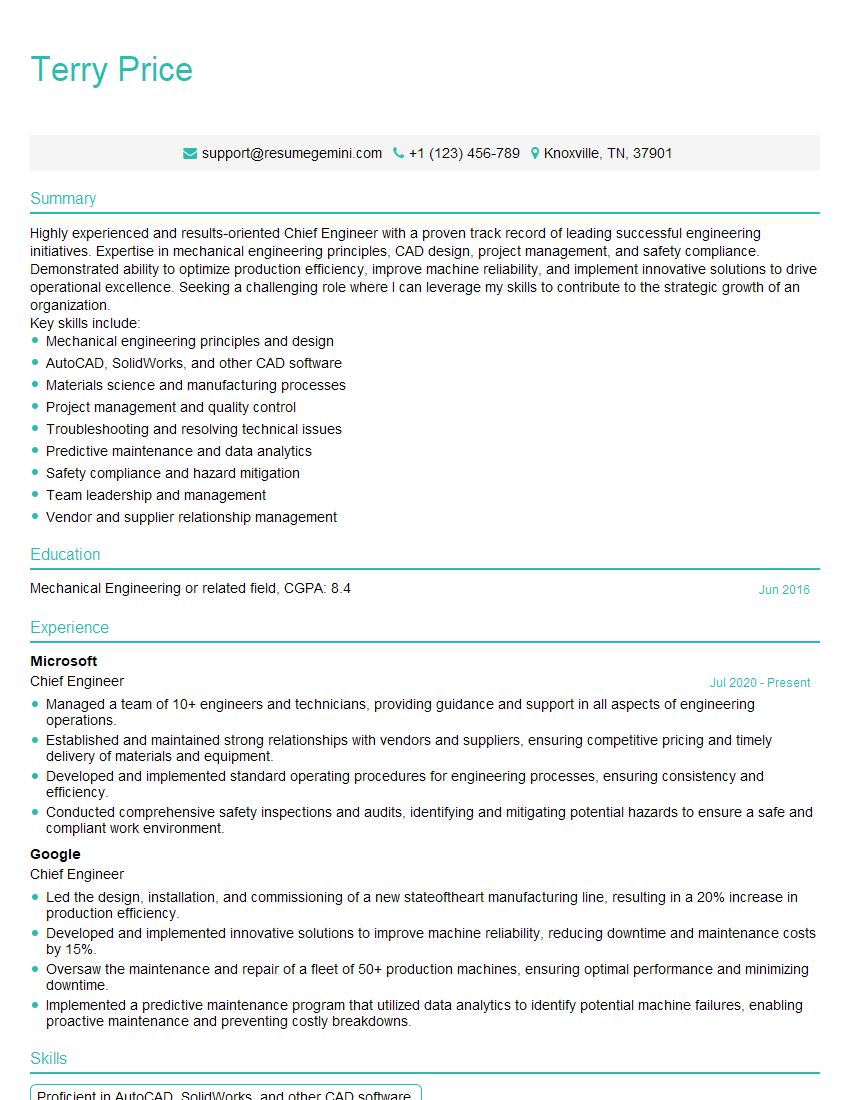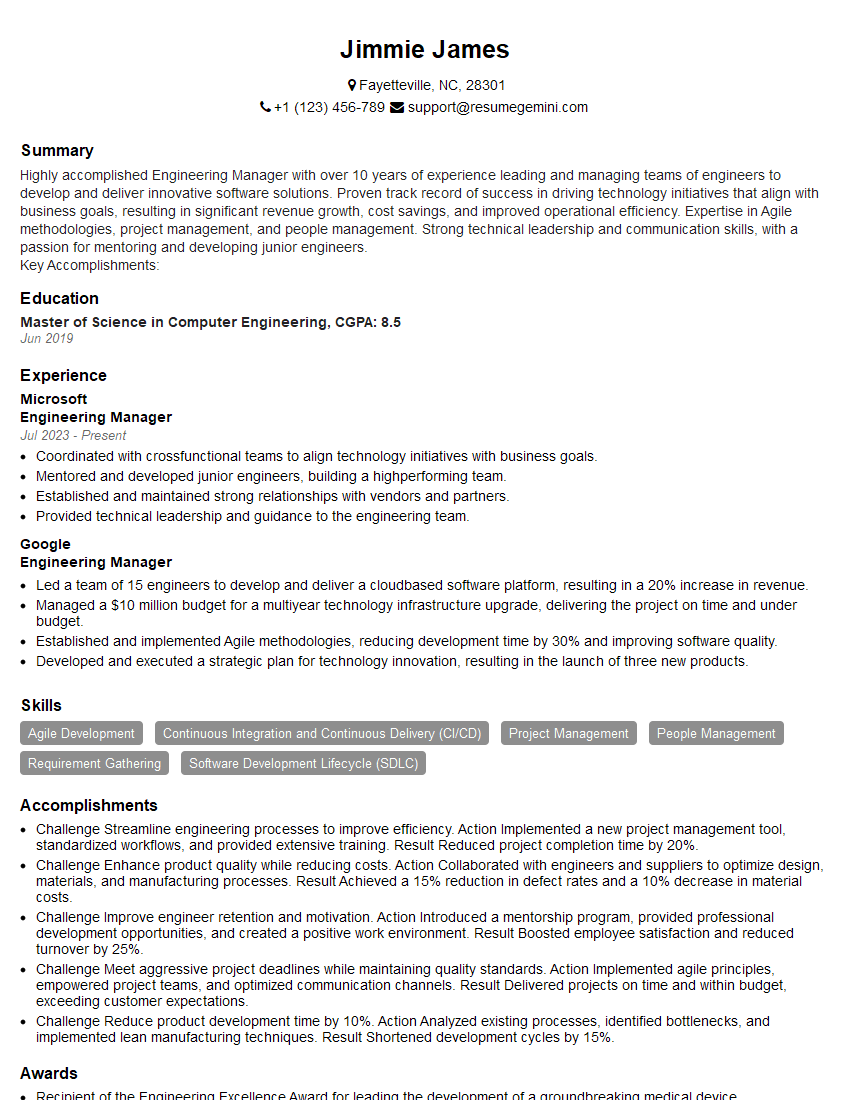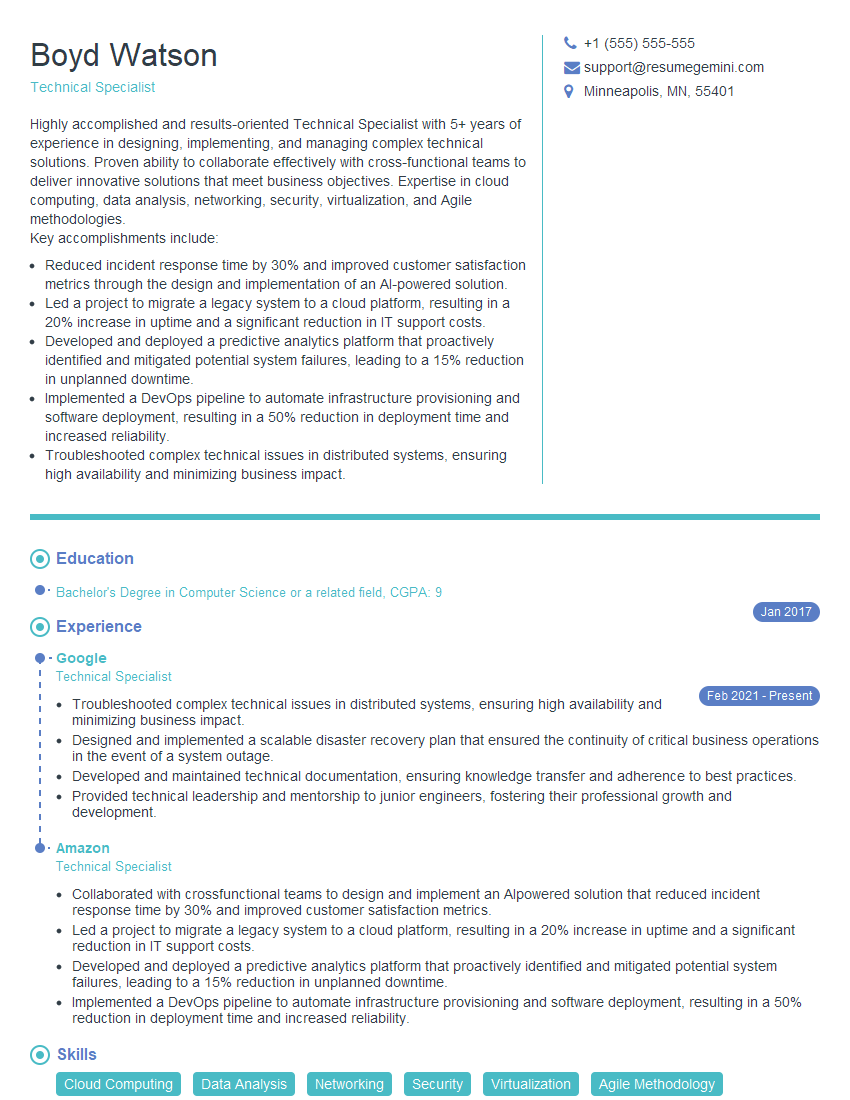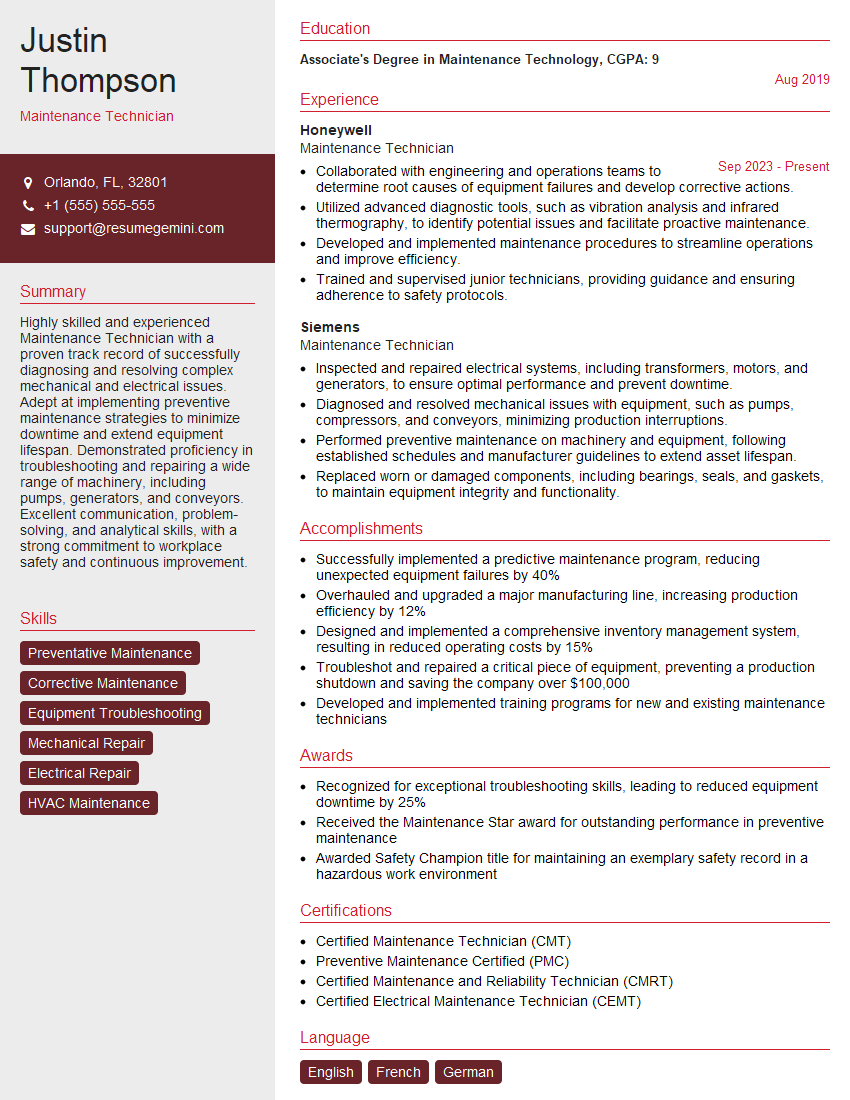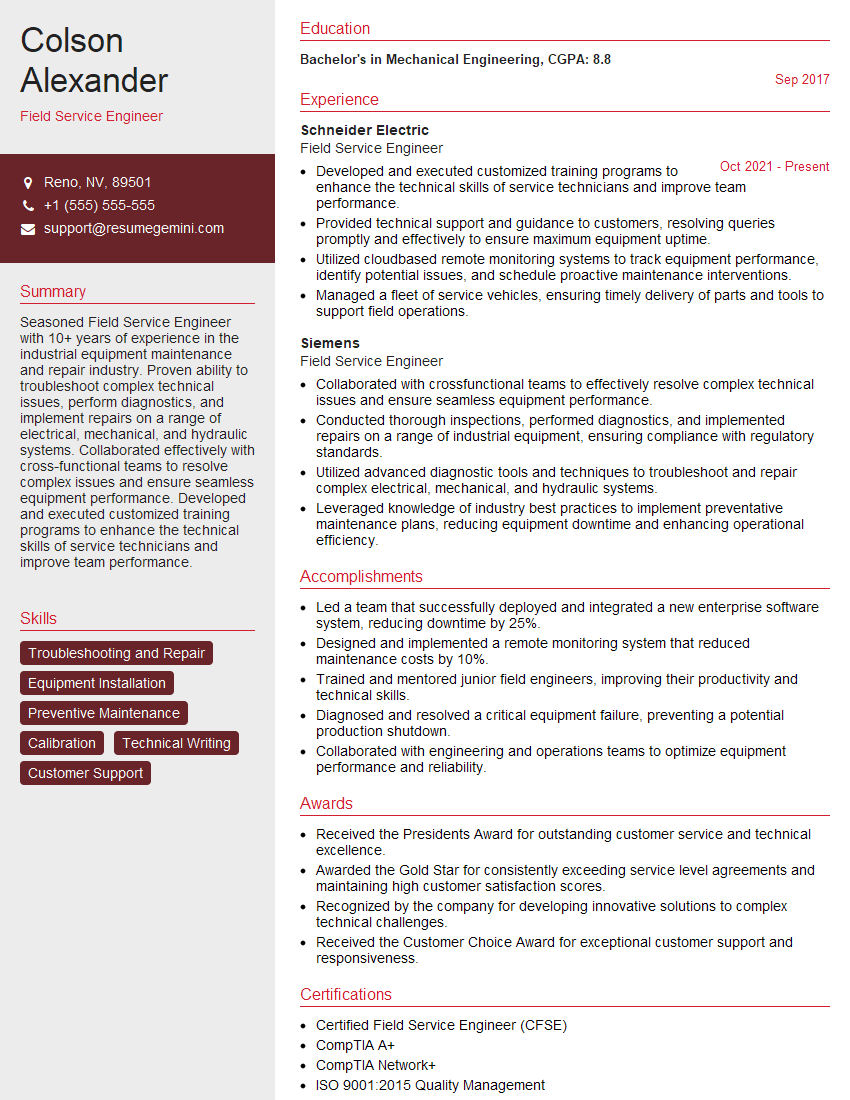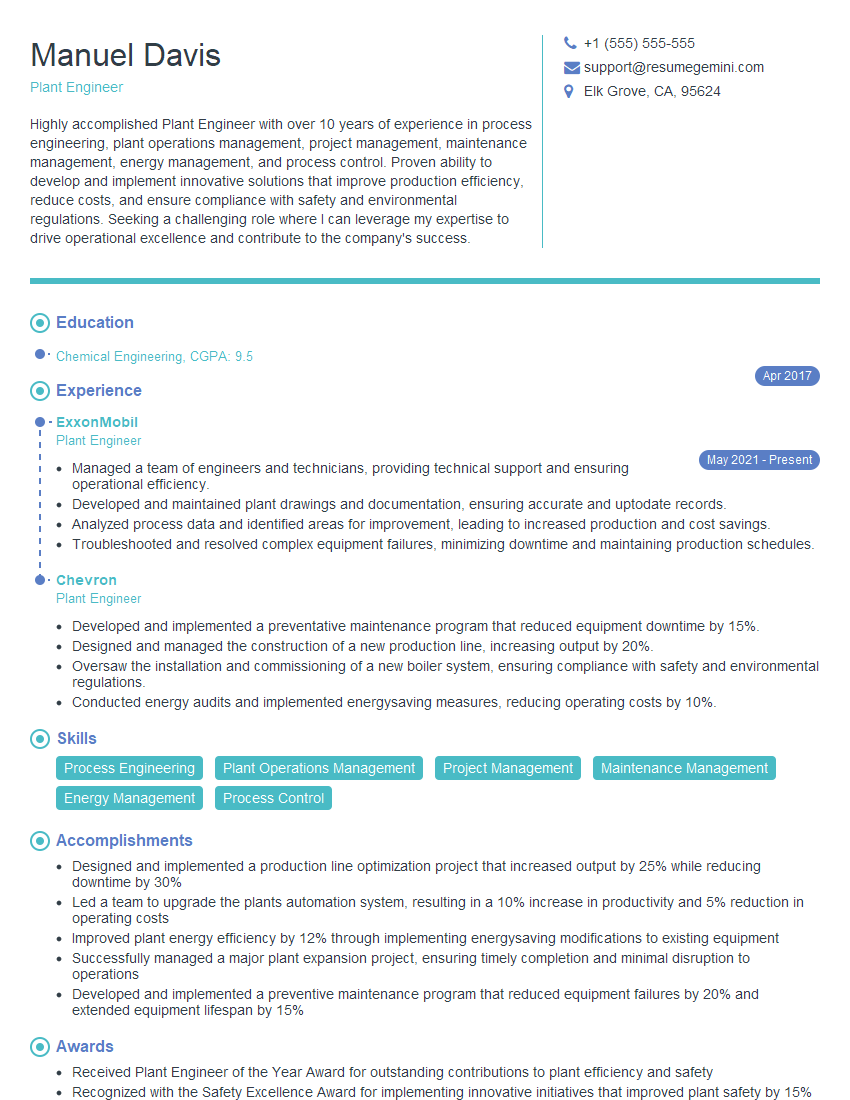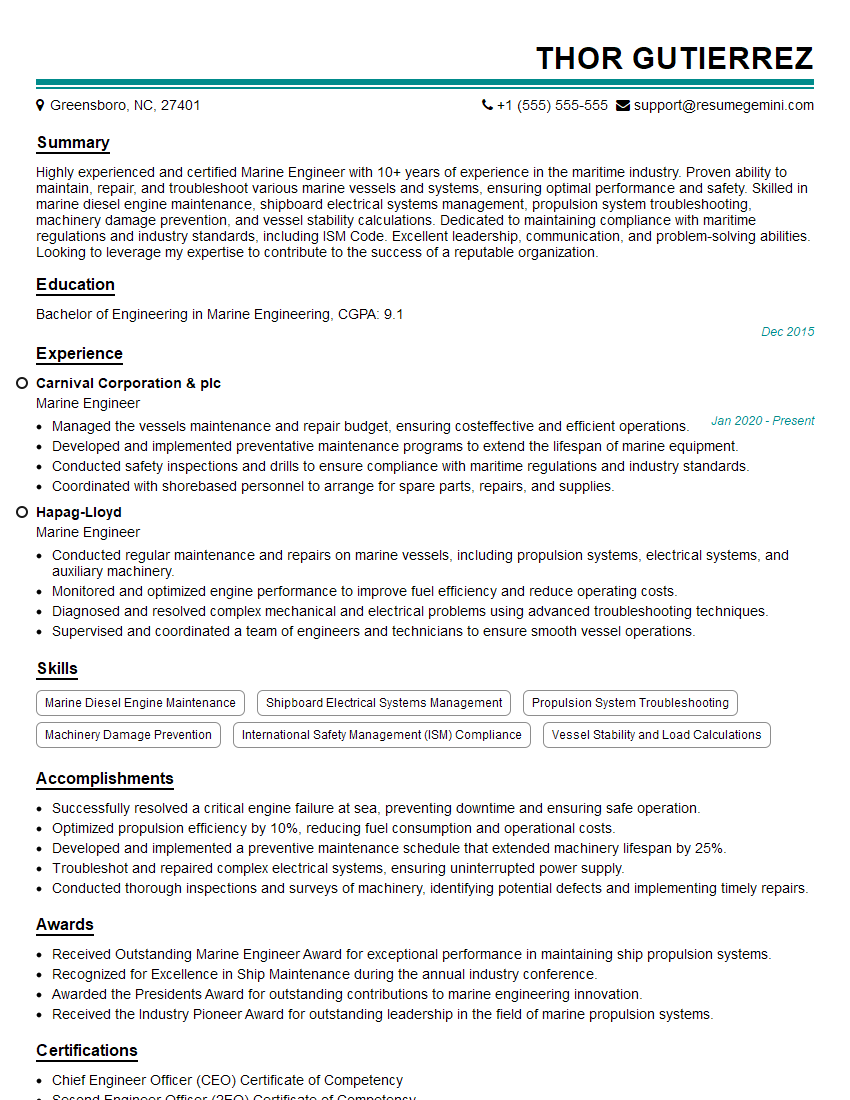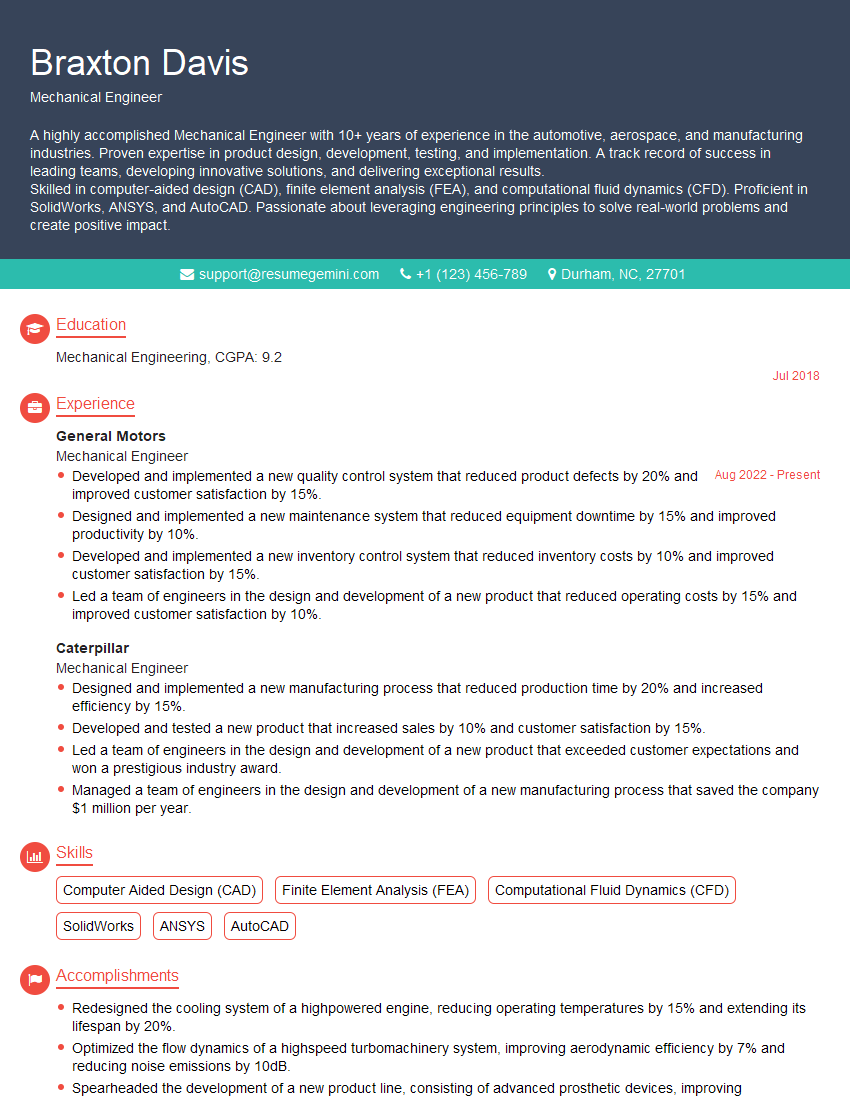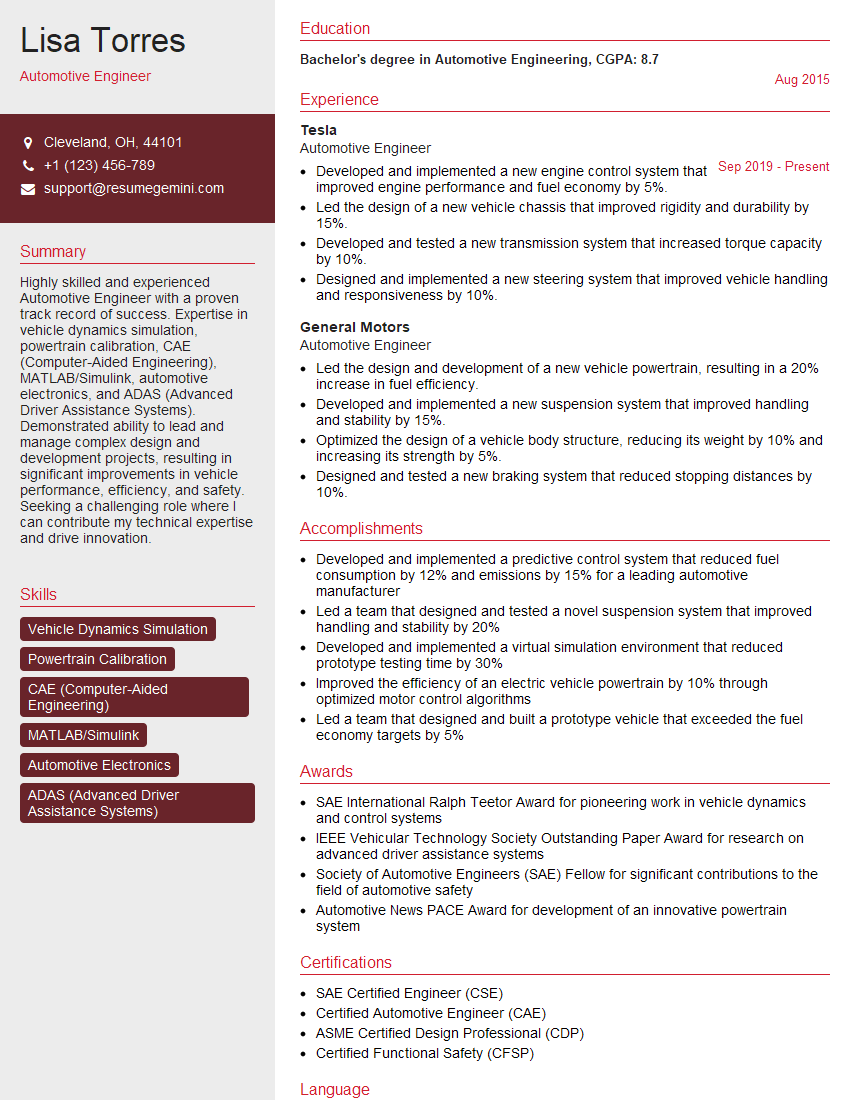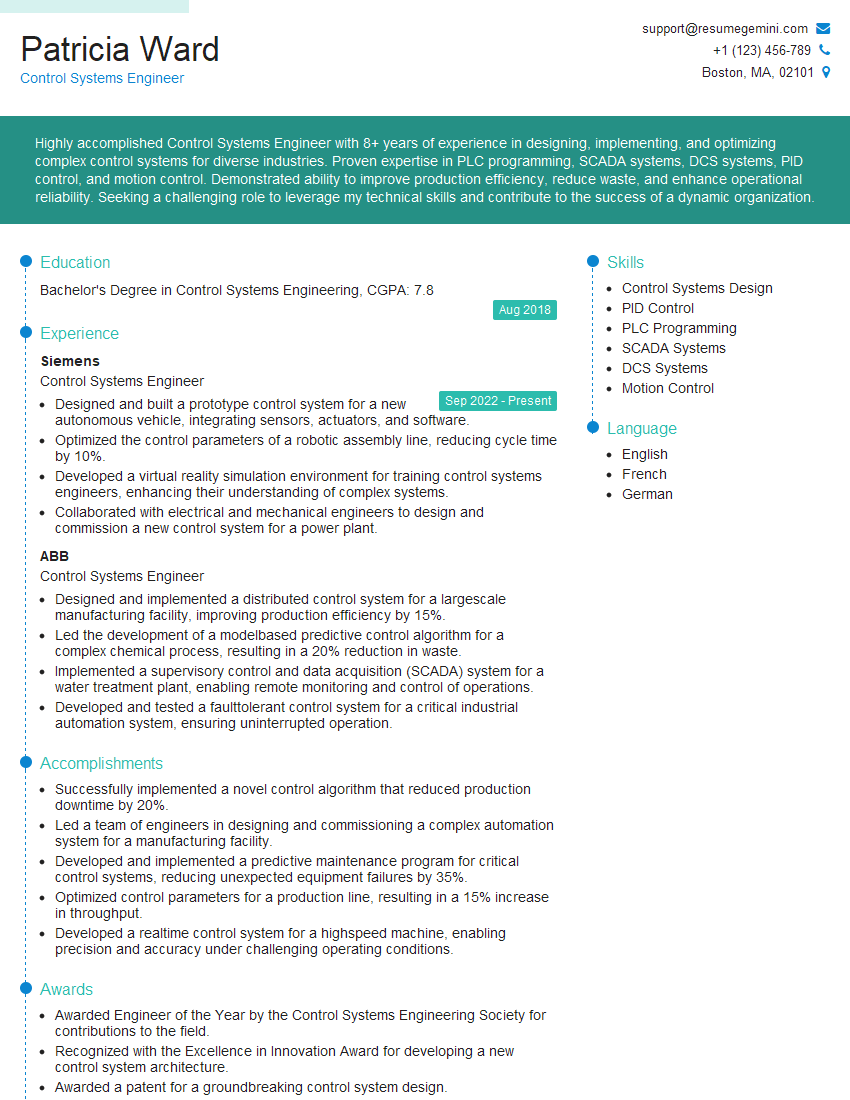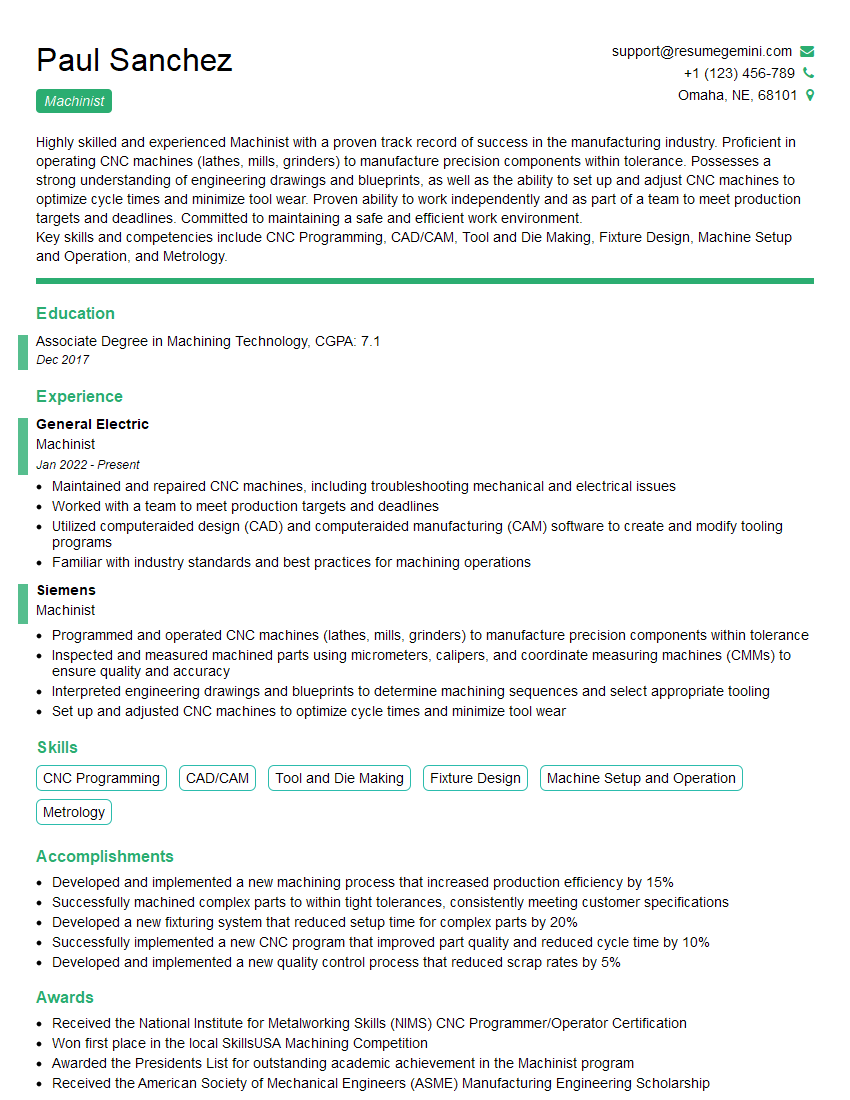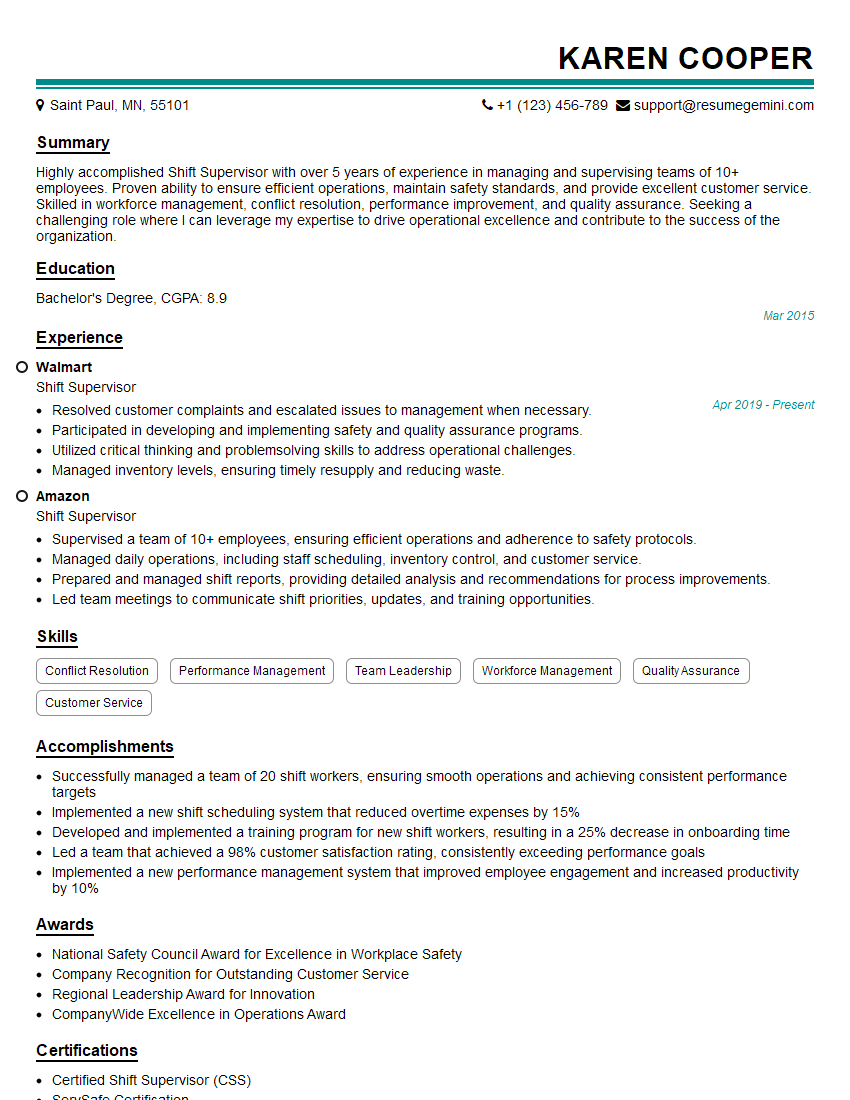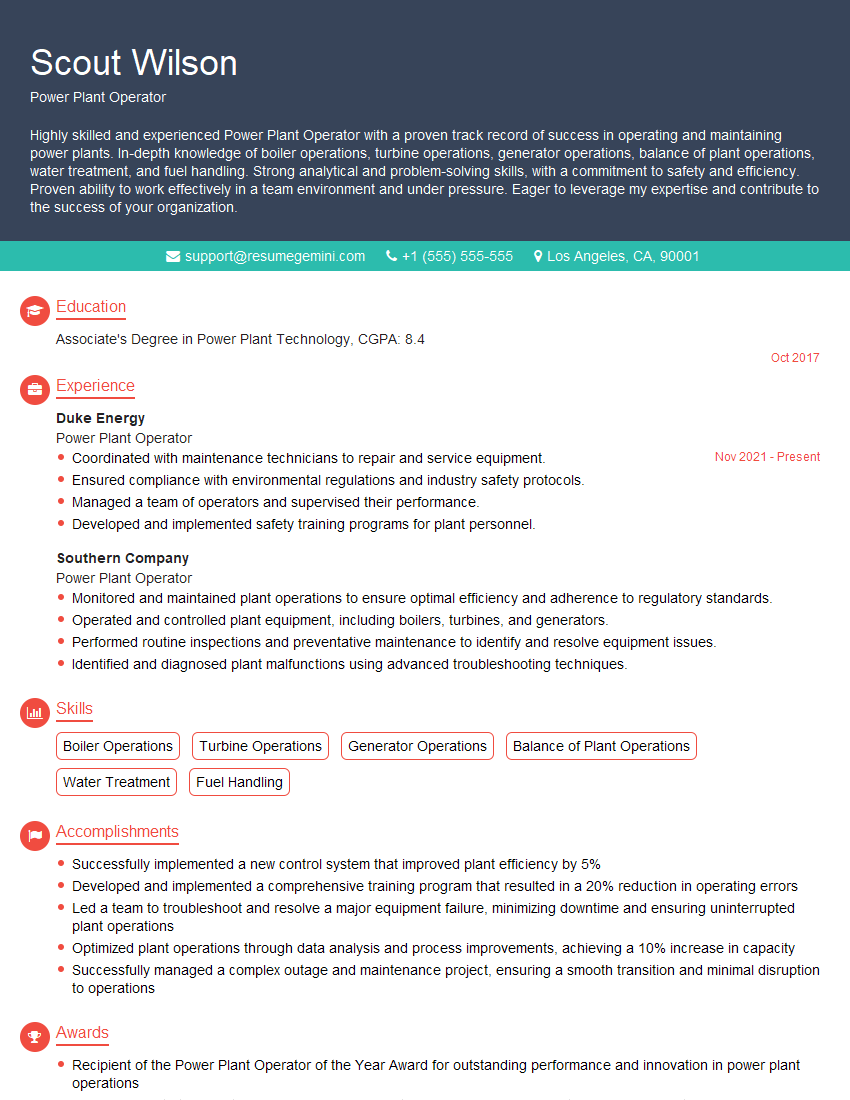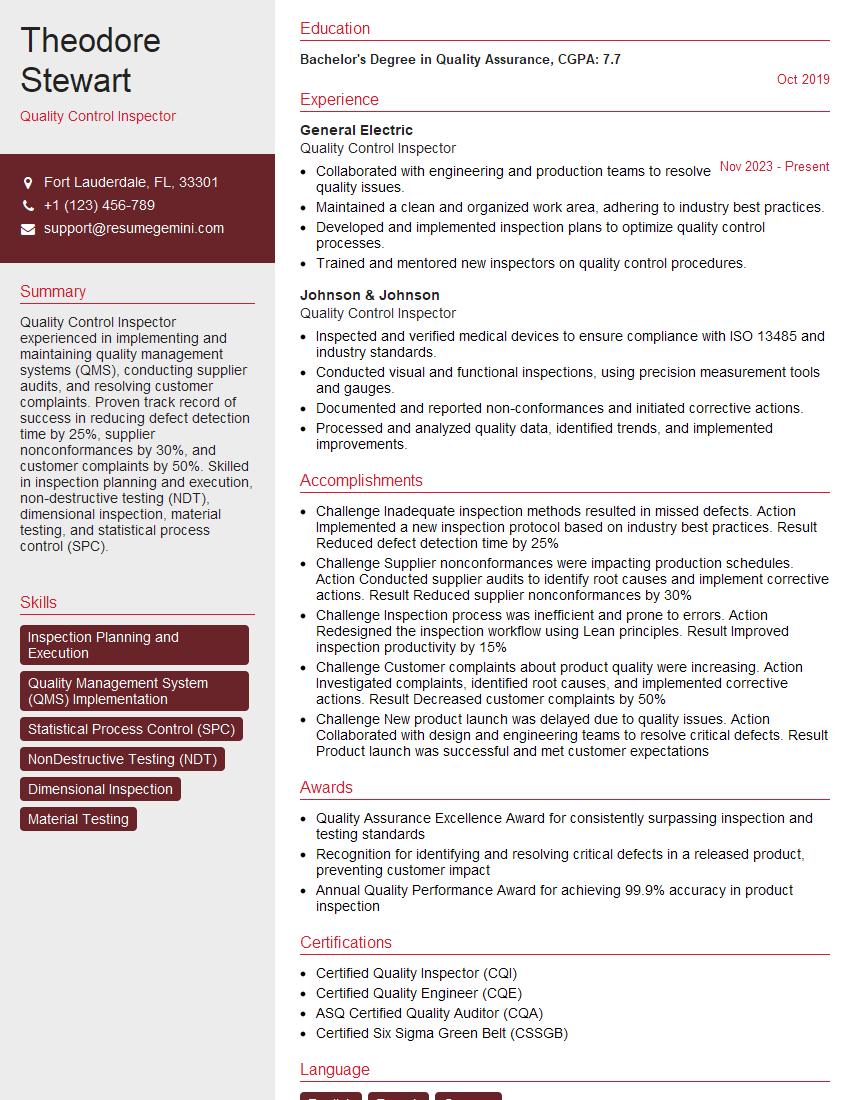Every successful interview starts with knowing what to expect. In this blog, we’ll take you through the top Engine Operation interview questions, breaking them down with expert tips to help you deliver impactful answers. Step into your next interview fully prepared and ready to succeed.
Questions Asked in Engine Operation Interview
Q 1. Explain the four-stroke engine cycle.
The four-stroke engine cycle is the fundamental process by which internal combustion engines convert fuel into mechanical energy. It’s a cyclical process involving four distinct piston strokes: intake, compression, power, and exhaust. Think of it like four steps in a dance that repeat continuously to generate power.
- Intake Stroke: The piston moves down, drawing a mixture of air and fuel (in a gasoline engine) or just air (in a diesel engine) into the cylinder through the open intake valve. Imagine inhaling – the cylinder is filling up.
- Compression Stroke: Both intake and exhaust valves close, and the piston moves up, compressing the air-fuel mixture (or just air) into a smaller volume. This increases pressure and temperature, preparing the mixture for ignition. Think of squeezing a balloon – you increase pressure and heat.
- Power Stroke: The compressed mixture is ignited (by a spark plug in a gasoline engine or by the heat of compression in a diesel engine). The resulting explosion forces the piston down, generating the power that drives the crankshaft and ultimately the wheels of a car or other machinery. This is the main event – the explosion that creates the power.
- Exhaust Stroke: The exhaust valve opens, and the piston moves up, pushing the spent gases out of the cylinder. Think of exhaling – getting rid of the waste products.
This entire four-stroke cycle repeats for every revolution of the crankshaft (or every two revolutions in a four-cylinder engine).
Q 2. Describe the different types of engine lubrication systems.
Engine lubrication systems are crucial for reducing friction and wear between moving parts. There are several types, each with its own advantages and disadvantages:
- Splash Lubrication: The simplest system; moving parts dip into an oil sump, splashing oil onto other components. It’s inexpensive but less precise in oil delivery and only suitable for low-speed, low-power engines like some small lawnmowers. Imagine dipping your fingers in water and then splashing it around – simple, but not very controlled.
- Pressure Lubrication: An oil pump circulates oil under pressure to all critical engine parts. This is the most common system in modern vehicles, offering consistent and precise lubrication. The oil is filtered to remove contaminants. This is like a sophisticated plumbing system ensuring every part gets the oil it needs, when it needs it.
- Combination Lubrication: This system combines elements of both splash and pressure lubrication, often using a pressure system for critical components and splash lubrication for others. It offers a balance between cost and performance.
- Dry-sump Lubrication: A separate oil tank is used, and an oil pump circulates oil at higher pressures. This is typically found in high-performance engines like race cars, as it allows for greater oil capacity and more efficient oil management during high-g maneuvers. This is like a dedicated oil reservoir with superior management.
The choice of system depends heavily on the engine’s design, power output, and intended application.
Q 3. What are the common causes of engine overheating?
Engine overheating is a serious issue that can lead to significant damage. Several factors can contribute:
- Low Coolant Levels: Insufficient coolant in the system reduces the cooling capacity.
- Faulty Thermostat: A malfunctioning thermostat can prevent coolant from circulating properly.
- Clogged Radiator: Debris or corrosion can restrict coolant flow through the radiator.
- Failed Water Pump: A non-functional water pump prevents the coolant from circulating.
- Blown Head Gasket: This allows coolant to leak into the cylinders, reducing cooling efficiency and potentially leading to catastrophic engine failure.
- Radiator Fan Problems: A non-functioning fan prevents adequate heat dissipation, especially at low speeds.
- Overworking the Engine: Prolonged operation under heavy load or high temperatures can overwhelm the cooling system.
Regular maintenance and inspections can significantly reduce the likelihood of overheating.
Q 4. How do you diagnose engine knocking?
Engine knocking, also known as detonation, is a harsh, metallic sound caused by the uncontrolled ignition of the air-fuel mixture. Diagnosing it involves several steps:
- Listen for the Sound: Knocking typically manifests as a sharp, rattling sound, particularly noticeable under load or acceleration. It’s quite distinct from other engine noises.
- Check for Low Octane Fuel: Using lower-octane fuel than recommended can easily lead to knocking. Ensure you’re using the appropriate fuel grade specified by the manufacturer.
- Inspect Ignition Timing: Incorrect ignition timing can also trigger knocking. This would require specialized tools and knowledge to adjust.
- Examine Compression Ratio: High compression engines are more prone to knocking. A compression test can help assess the engine’s health.
- Inspect for Carbon Build-up: Excessive carbon deposits can lead to knocking. Regular engine maintenance, including carbon cleaning, can prevent this.
Ignoring engine knocking can lead to serious damage, so addressing the root cause is crucial.
Q 5. Explain the function of an engine cooling system.
The engine cooling system’s primary function is to maintain the engine’s operating temperature within its optimal range. Overheating can cause severe damage, while operating too cold can reduce efficiency. The system typically involves several key components:
- Coolant (Antifreeze): A mixture of water and antifreeze that circulates through the system, absorbing heat from the engine.
- Water Pump: A pump that circulates the coolant through the system.
- Radiator: A heat exchanger that dissipates heat from the coolant into the surrounding air.
- Radiator Fan: Assists the radiator in dissipating heat, especially at low speeds.
- Thermostat: Regulates coolant flow to maintain optimal operating temperature. It controls when coolant flows through the radiator to cool the system or stays in the engine block when warm-up is needed.
A well-functioning cooling system is essential for reliable engine operation and longevity.
Q 6. What are the safety procedures for working on an engine?
Safety is paramount when working on any engine. Here are some essential procedures:
- Disconnect the Battery: Always disconnect the negative battery terminal to prevent accidental electrical shorts or shocks.
- Use Proper Tools: Employ the correct tools for the task to avoid injury and damage.
- Wear Protective Gear: Safety glasses, gloves, and closed-toe shoes are essential to protect against potential hazards.
- Work in a Well-Ventilated Area: Engine fumes are toxic and can cause serious health problems.
- Support the Engine Properly: Ensure the engine is adequately supported to prevent it from falling and causing injury.
- Use Jack Stands: If using a jack, always support the engine with jack stands for added safety.
- Dispose of Fluids Properly: Used oil, coolant, and other fluids should be disposed of according to local regulations.
Never compromise on safety; it’s far better to take precautions than to risk injury or damage.
Q 7. How do you perform a pre-operational engine inspection?
A pre-operational engine inspection is vital to ensure safe and efficient operation. The inspection should include:
- Visual Inspection: Check for any obvious damage, leaks, loose connections, or corrosion.
- Fluid Levels: Check oil, coolant, and other fluid levels and ensure they are within the acceptable range.
- Belt Tension: Inspect the drive belts for proper tension and wear.
- Hoses and Connections: Examine hoses and connections for cracks, leaks, or damage.
- Battery Terminals: Inspect the battery terminals for corrosion and ensure a secure connection.
- Wiring: Check the wiring for any damage or loose connections.
- Fuel System: Check the fuel lines and connections for leaks or damage.
This routine inspection will help prevent unexpected breakdowns and ensure your engine operates safely and efficiently.
Q 8. Describe the process of changing engine oil and filters.
Changing engine oil and filters is crucial for maintaining engine health. Think of it like giving your engine a regular bath and fresh clothes! It involves several steps to ensure proper execution.
- Warm-up the engine: Run the engine for a few minutes to warm the oil, allowing it to flow more easily.
- Gather your supplies: You’ll need the correct type and grade of oil (check your owner’s manual), a new oil filter, a wrench or filter cap remover, a drain pan, and funnel.
- Locate the oil drain plug: This is usually located on the bottom of the engine oil pan. Place the drain pan underneath.
- Drain the old oil: Carefully loosen and remove the drain plug, letting the old oil drain completely into the pan. Be cautious, as the oil will be hot.
- Replace the oil filter: Locate the oil filter, usually near the engine block. Use the wrench to remove the old filter. Lightly lubricate the rubber gasket of the new filter with fresh oil before screwing it in by hand. Tighten it according to the manufacturer’s instructions.
- Replace the drain plug: Once the old oil has drained, reinstall the drain plug, tightening it securely but not overtightening to avoid stripping the threads.
- Add new oil: Using the funnel, pour the correct amount of new oil into the engine. Check your owner’s manual for the specific quantity.
- Check the oil level: Use the dipstick to check the oil level. Add more oil if necessary, ensuring it’s within the recommended range.
- Start the engine: Run the engine for a few minutes to circulate the new oil and check for leaks around the drain plug and oil filter.
- Recheck oil level: After running the engine, turn it off and wait a few minutes before checking the oil level again. Top it off if needed.
Remember to dispose of the old oil and filter responsibly at a designated recycling center.
Q 9. What are the signs of a malfunctioning fuel injection system?
A malfunctioning fuel injection system can manifest in several ways, impacting engine performance significantly. Think of it as a vital part of your engine’s digestive system – if it’s not working correctly, the engine won’t run smoothly.
- Rough idle or stalling: The engine may struggle to maintain a consistent idle speed, sometimes even stalling completely.
- Poor fuel economy: A faulty system can lead to excessive fuel consumption, as the engine isn’t receiving the optimal fuel-air mixture.
- Hesitation or lack of power: The engine may hesitate during acceleration or experience a noticeable loss of power.
- Black smoke from the exhaust: This indicates a rich fuel mixture, meaning too much fuel is being injected into the engine.
- Engine misfires: Unburnt fuel can lead to misfires, resulting in a rough running engine and potentially causing damage to the catalytic converter.
- Check engine light: The vehicle’s diagnostic system will likely illuminate the ‘check engine’ light, indicating a problem that needs attention.
These symptoms can be caused by various issues within the fuel injection system, including faulty injectors, a clogged fuel filter, low fuel pressure, or problems with the fuel pump or control module. A diagnostic scan is often needed to pinpoint the exact cause.
Q 10. How do you troubleshoot an engine that won’t start?
Troubleshooting an engine that won’t start is a systematic process of elimination. It’s like solving a puzzle; you need to check each piece until you find the missing one.
- Check the battery: Ensure the battery terminals are clean and tightly connected. Use a voltmeter to check the battery voltage. A low voltage indicates a weak or dead battery.
- Verify the starter motor: Listen for the starter motor’s engagement. If you hear a clicking sound but the engine doesn’t crank, it could be a faulty starter motor, low battery voltage, or a bad connection.
- Inspect the fuel system: Check if there’s fuel in the tank. A fuel pump issue or a clogged fuel filter can prevent fuel from reaching the engine.
- Examine the ignition system: Verify that there’s spark at the spark plugs. This often requires specialized tools and knowledge of the ignition system’s components.
- Check for obvious issues: Inspect for loose or broken wires, damaged components, and any obvious signs of damage or leaks.
- Use a diagnostic tool: A scan tool can retrieve diagnostic trouble codes (DTCs) from the engine control unit (ECU), providing valuable clues about potential problems.
Remember safety first! Always disconnect the negative battery terminal before working on the electrical system.
Q 11. Explain the importance of regular engine maintenance.
Regular engine maintenance is paramount to ensuring your engine’s longevity and optimal performance. Think of it as preventative healthcare for your vehicle; regular checkups prevent major problems later on.
- Extended engine life: Regular oil changes, filter replacements, and inspections prevent premature wear and tear on engine components.
- Improved fuel efficiency: A well-maintained engine operates more efficiently, resulting in better gas mileage.
- Reduced emissions: Proper maintenance minimizes harmful emissions, contributing to a cleaner environment.
- Enhanced engine performance: Regular maintenance ensures that the engine runs smoothly and delivers optimal power.
- Cost savings: Preventative maintenance is significantly cheaper than repairing major engine problems that arise from neglect.
- Safety: A well-maintained engine is a safer engine, reducing the risk of breakdowns and potential accidents.
Following the manufacturer’s recommended maintenance schedule is key. Neglecting maintenance can lead to costly repairs or even catastrophic engine failure.
Q 12. Describe the different types of engine fuel systems.
Engine fuel systems have evolved over time, with several key types prevalent today. Each system has its own approach to delivering fuel to the engine.
- Carburetor System: This older system uses a carburetor to mix air and fuel before entering the engine’s combustion chambers. It’s simpler than fuel injection but less efficient and precise.
- Throttle Body Fuel Injection (TBFI): This system uses a single injector located in the throttle body to inject fuel into the intake manifold. It’s a relatively simple fuel injection system.
- Multi-Point Fuel Injection (MPFI): This system uses multiple injectors, one for each cylinder, precisely controlling the fuel delivery to each cylinder for optimal combustion. It offers better fuel efficiency and performance compared to TBFI.
- Direct Fuel Injection (DI): In this advanced system, fuel is directly injected into the combustion chamber, allowing for more precise control over fuel delivery and combustion. It typically leads to higher fuel efficiency and power output.
The choice of fuel system depends on various factors including the engine design, desired performance characteristics, and emission regulations.
Q 13. What are the common causes of engine misfires?
Engine misfires are characterized by the incomplete or failed combustion of fuel in one or more cylinders. This leads to a loss of power, rough running, and potentially engine damage. It’s like a single musician missing a note in an orchestra; the overall performance is disrupted.
- Faulty spark plugs: Worn, damaged, or improperly gapped spark plugs can fail to ignite the air-fuel mixture.
- Worn or damaged ignition wires: Cracks or breaks in the ignition wires can prevent the spark from reaching the spark plugs.
- Problems with the ignition coil: A faulty ignition coil may not provide sufficient voltage to generate a strong spark.
- Low fuel pressure: Insufficient fuel pressure can prevent the proper delivery of fuel to the cylinders.
- Faulty fuel injectors: Clogged or malfunctioning fuel injectors can prevent the correct amount of fuel from being delivered.
- Vacuum leaks: Leaks in the intake system can disrupt the proper air-fuel mixture.
- Faulty sensors: Malfunctioning sensors, such as the crankshaft position sensor or mass airflow sensor, can disrupt the engine’s timing and fuel delivery.
Diagnosing the exact cause requires a systematic approach, using diagnostic tools and tests to pinpoint the faulty component.
Q 14. How do you interpret engine performance data?
Interpreting engine performance data is crucial for diagnosing problems and ensuring optimal engine operation. Think of it as reading a patient’s vital signs; each data point tells a story.
Common data points include:
- Fuel consumption: High fuel consumption can indicate problems with the fuel injection system, air intake system, or engine wear.
- Engine RPM and Load: Monitoring these parameters helps assess the engine’s response to different operating conditions.
- Air-fuel ratio: An improper air-fuel ratio can indicate problems with the fuel system, air intake system, or oxygen sensors.
- Exhaust gas temperature (EGT): EGT variations can indicate problems with combustion, such as misfires or incomplete combustion.
- Cylinder pressure: Low cylinder pressure in one or more cylinders can indicate problems such as valve issues, piston ring problems, or head gasket failure.
- Diagnostic Trouble Codes (DTCs): These codes from the ECU provide valuable clues about potential problems.
Specialized diagnostic tools and software are used to collect and interpret this data, enabling technicians to pinpoint and resolve engine performance issues effectively.
Q 15. Explain the function of an engine’s exhaust system.
The exhaust system is crucial for safely expelling harmful combustion byproducts from the engine. It’s more than just a pipe; it’s a carefully engineered system that manages exhaust gases’ temperature, pressure, and composition.
- Exhaust Manifold/Headers: Collects exhaust gases from each cylinder and directs them into a single stream.
- Exhaust Pipes/Converters: Transport the gases, often incorporating catalytic converters to reduce harmful emissions like carbon monoxide and nitrogen oxides. In some systems, there might also be particulate filters to trap soot particles.
- Muffler: Reduces the noise generated by the exhaust gases by using chambers and baffles to dampen sound waves. This is crucial for both environmental noise reduction and driver comfort.
- Tailpipe: The final outlet for the exhaust gases.
Think of it like a sophisticated ventilation system for your engine. If it malfunctions, you’ll have dangerous fumes and excessive noise – and potentially damage to the engine itself.
Career Expert Tips:
- Ace those interviews! Prepare effectively by reviewing the Top 50 Most Common Interview Questions on ResumeGemini.
- Navigate your job search with confidence! Explore a wide range of Career Tips on ResumeGemini. Learn about common challenges and recommendations to overcome them.
- Craft the perfect resume! Master the Art of Resume Writing with ResumeGemini’s guide. Showcase your unique qualifications and achievements effectively.
- Don’t miss out on holiday savings! Build your dream resume with ResumeGemini’s ATS optimized templates.
Q 16. What are the different types of engine combustion chambers?
Engine combustion chambers are classified primarily by their shape and how the fuel and air are mixed. Key types include:
- Wedge Chamber: A simple design with a flat or slightly angled piston crown. Common in older engines, its simplicity contributes to robust design but at the expense of efficiency.
- Hemispherical Chamber (Hemi): A half-sphere-shaped combustion chamber. This design promotes efficient combustion by providing a more uniform distribution of the fuel-air mixture, leading to better performance and reduced emissions. The famous Chrysler Hemi engine exemplifies this design.
- Pentroof Chamber: Features a sloped or ‘pent’ roof shape. This geometry promotes good squish (compression of the fuel-air mixture just before ignition) and contributes to efficient burning.
- Overhead Valve (OHV) and Overhead Cam (OHC): These aren’t chamber shapes themselves, but rather valve train configurations that significantly impact combustion chamber efficiency. OHC engines typically offer more precise valve control and higher potential for performance and efficiency.
The choice of combustion chamber design depends on factors like engine size, fuel type, desired performance, and emission regulations.
Q 17. How do you identify and repair engine leaks?
Identifying engine leaks requires systematic observation and testing. Common locations include oil seals, gaskets, and hoses.
- Visual Inspection: Carefully examine the engine for obvious leaks – wet spots, drips, or trails of oil, coolant, or fuel. Pay close attention to areas where components join.
- Pressure Testing: For cooling system leaks, pressurize the cooling system with a tester. Leaks will show up as escaping bubbles or pressure drops.
- Dye Testing: Using a dye that’s compatible with the fluid (oil or coolant), run the engine and check for fluorescent leaks with a UV light. This is great for pinpointing hard-to-find leaks.
Repairs vary based on the type and location of the leak. Often this involves replacing seals, gaskets, or hoses. It’s essential to use the correct type of sealant or gasket material for optimal performance and durability.
Example: A leaking valve cover gasket is usually remedied by carefully removing the old gasket, cleaning the surfaces, applying a new gasket, and reinstalling the valve cover.
Q 18. Describe the process of adjusting engine valves.
Valve adjustment ensures proper valve clearance (lash or gap) between the valve stem and the rocker arm (or camshaft lobe in an overhead cam engine). Incorrect clearance leads to inefficient combustion, reduced performance, and potential engine damage. This adjustment is usually done with shims or adjusting screws.
- Measurement: Use a feeler gauge to measure the existing clearance. The appropriate clearance varies depending on the engine; this specification is found in the engine’s service manual.
- Adjustment (Shim Method): Remove the rocker arm, measure the clearance, and replace the shim with one of a different thickness to achieve the correct clearance. Reassemble the rocker arm and check the clearance again.
- Adjustment (Screw Method): Use a wrench to turn the adjusting screw to obtain the correct clearance. This requires careful adjustment to avoid over-tightening, which can damage the valve mechanism.
The procedure is quite involved and requires specific tools and knowledge of the engine’s design. Improper adjustment can severely damage the engine.
Q 19. What are the safety precautions for handling engine fluids?
Handling engine fluids requires strict adherence to safety precautions to avoid injury and environmental contamination.
- Personal Protective Equipment (PPE): Always wear gloves, eye protection, and appropriate clothing. Some fluids are corrosive or toxic.
- Proper Disposal: Engine oil, coolant, and other fluids must be disposed of properly. Never pour them down the drain or onto the ground. Use designated recycling centers or disposal facilities.
- Ventilation: Work in a well-ventilated area to avoid inhaling fumes. Some engine fluids release hazardous vapors.
- Fire Safety: Be aware that many engine fluids are flammable. Keep away from open flames or sparks.
- Spill Cleanup: Have absorbent materials ready to clean up any spills immediately. Dispose of contaminated materials properly.
Remember, a small spill can have significant environmental consequences, so always prioritize safety and responsible disposal.
Q 20. Explain the principle of engine compression.
Engine compression is the pressure created in the cylinder when the piston compresses the air-fuel mixture (in gasoline engines) or just air (in diesel engines) before ignition. This compression is vital for efficient combustion.
In a gasoline engine, the compressed mixture’s pressure and temperature increase significantly. When the spark plug fires, this highly compressed and heated mixture ignites rapidly and forcefully, generating the power to move the piston. Higher compression generally leads to better fuel efficiency and power output.
In a diesel engine, the compression is even more extreme. The immense pressure and heat ignite the injected fuel spontaneously (without the need for a spark plug), which is a characteristic feature of diesel combustion.
Think of it like squeezing a balloon – the more you squeeze (compress), the more energy is stored, ready to be released (combustion) when you let go (ignition).
Q 21. How do you perform a cylinder compression test?
A cylinder compression test measures the pressure within each cylinder during the compression stroke. It provides valuable information about the engine’s overall health and can pinpoint problems like worn piston rings, leaky valves, or a blown head gasket.
- Preparation: Ensure the engine is cold, the battery is fully charged, and the spark plugs are removed (or the glow plugs in a diesel).
- Testing Procedure: Connect a compression gauge to the spark plug hole (or glow plug hole). Crank the engine for a specific duration (typically until the gauge stops rising). Record the pressure reading for each cylinder.
- Interpretation: Compare the readings to the manufacturer’s specifications for the engine. Significant variations between cylinders or low readings in one or more cylinders indicate potential problems.
- Further Investigation: Low compression in a single cylinder might indicate a problem with the valves, piston rings, or head gasket in that cylinder. Consistent low compression across all cylinders may point to a more significant issue such as a worn piston or a major engine problem.
A compression test is a fundamental diagnostic procedure for any engine mechanic and requires specialized tools, a compression gauge, and a well-grounded understanding of engine operation.
Q 22. What are the different types of engine governors?
Engine governors are crucial for controlling the speed of an engine. They prevent overspeeding and ensure consistent operation under varying loads. There are several types, each with its own mechanism:
- Mechanical Governors: These use centrifugal force or flyweights to regulate fuel delivery. As engine speed increases, the flyweights move outward, restricting fuel flow. Think of it like a spinning top – the faster it spins, the wider it spreads its arms.
- Hydraulic Governors: These utilize hydraulic pressure to control the fuel supply. Changes in engine speed alter the hydraulic pressure, affecting the fuel metering system. These are often more precise than mechanical governors.
- Electronic Governors: These are the most sophisticated type, using sensors and electronic control units (ECUs) to precisely manage engine speed based on various inputs, such as throttle position, load, and even environmental conditions. They offer excellent precision and adaptability.
- Pneumatic Governors: These use compressed air to control fuel delivery. While less common now, they were prevalent in older systems.
The choice of governor depends on the application. Simple machinery might use a mechanical governor, while modern vehicles and sophisticated industrial equipment typically utilize electronic governors for greater efficiency and control.
Q 23. Describe the function of a turbocharger or supercharger.
Turbochargers and superchargers are both forced induction systems that increase the power output of an internal combustion engine. They achieve this by forcing more air into the combustion chamber, leading to a more complete burn of fuel and increased power.
The key difference lies in how they achieve this:
- Turbochargers: Utilize exhaust gases to spin a turbine, which in turn drives a compressor that forces air into the engine. They are efficient because they use energy that would otherwise be wasted.
- Superchargers: Are mechanically driven, usually by a belt connected to the engine’s crankshaft. This means they consume engine power to operate. However, they offer immediate boost response, unlike turbochargers which have a slight lag.
Imagine blowing air into a balloon. A turbocharger is like using the balloon’s own expanding air to push more air in, while a supercharger is like directly blowing into the balloon using your own breath. Both achieve the same goal – a larger, more inflated balloon (more power), but through different mechanisms.
Q 24. How do you troubleshoot a problem with an engine’s ignition system?
Troubleshooting an engine’s ignition system requires a systematic approach. It’s like solving a puzzle, identifying which piece is missing or malfunctioning. Here’s a common strategy:
- Visual Inspection: Start by examining the ignition components: wires, spark plugs, distributor cap (if applicable), ignition coil, and crankshaft position sensor. Look for any visible damage, corrosion, or loose connections.
- Testing Spark Plugs: Use a spark plug tester or carefully remove the spark plugs one at a time. Ground them against the engine block and crank the engine to check for a strong, blue spark. Weak or absent sparks indicate a problem with the plug or ignition system.
- Checking Ignition Coil: Test the ignition coil’s primary and secondary windings using a multimeter to ensure it’s delivering the correct voltage. A faulty coil can prevent spark generation.
- Inspecting Wiring and Connections: Carefully examine all wires and connectors for damage, breaks, or poor connections. A simple loose wire can disrupt the entire system.
- Testing Crankshaft Position Sensor (CKP): This sensor is crucial for precise timing of the spark. A malfunctioning CKP sensor can lead to misfires or no spark at all. Test it using an oscilloscope or a dedicated diagnostic tool.
- Using Diagnostic Tools: Modern vehicles utilize OBD-II systems (on-board diagnostics). A scan tool can retrieve trouble codes that pinpoint specific problems within the ignition system.
Remember safety first! Always disconnect the battery before working on the ignition system to avoid shocks.
Q 25. Explain the difference between a diesel and gasoline engine.
Diesel and gasoline engines are both internal combustion engines, but they differ significantly in their fuel-air mixture, ignition process, and overall operation.
- Fuel-Air Mixture: Gasoline engines rely on a carefully metered mixture of gasoline and air that is ignited by a spark plug. Diesel engines, on the other hand, compress air to very high temperatures and pressures, then inject fuel. The fuel auto-ignites due to the heat.
- Ignition: Gasoline engines use spark plugs for ignition, while diesel engines rely on the heat generated by compression.
- Efficiency: Diesel engines are typically more fuel-efficient than gasoline engines, especially under heavy loads, due to their higher compression ratios and more complete combustion.
- Emissions: Diesel engines historically produced more particulate matter and nitrogen oxides, although modern diesel engines with advanced emission control systems have significantly reduced these emissions. Gasoline engines tend to produce more carbon monoxide and unburned hydrocarbons.
- Torque: Diesel engines typically produce higher torque at lower RPMs, making them ideal for heavy-duty applications.
Think of it like this: a gasoline engine is like a finely tuned precision instrument, needing a precise spark to ignite the fuel. A diesel engine is more like a powerful, heavy-duty machine that relies on brute force (compression) to ignite the fuel.
Q 26. What are the environmental regulations related to engine emissions?
Environmental regulations concerning engine emissions are stringent and constantly evolving, aimed at minimizing harmful pollutants. Regulations vary by region and are typically based on emission standards for pollutants such as:
- Carbon Monoxide (CO): A toxic gas produced by incomplete combustion.
- Hydrocarbons (HC): Unburned or partially burned fuel.
- Nitrogen Oxides (NOx): Formed during high-temperature combustion.
- Particulate Matter (PM): Fine particles that contribute to air pollution.
Examples include: Euro standards in Europe, Tier standards in North America, and Bharat Stage standards in India. These regulations often specify limits for each pollutant, requiring the use of emission control systems like catalytic converters, diesel particulate filters (DPFs), and selective catalytic reduction (SCR) systems. Non-compliance can result in fines and legal penalties.
These regulations are crucial for improving air quality and protecting public health. Meeting these standards requires constant innovation in engine design and emission control technologies.
Q 27. How do you perform a basic engine performance analysis?
A basic engine performance analysis involves evaluating how well the engine is operating. This assessment can be quite simple or highly detailed, depending on the available tools and the depth of the analysis needed.
- Visual Inspection: Start with a visual inspection of the engine, checking for leaks, loose connections, or signs of damage. This provides initial clues to potential problems.
- Compression Test: A compression test measures the pressure in each cylinder during compression stroke. Low compression can indicate worn piston rings, valve problems, or head gasket issues.
- Fuel Consumption Analysis: Monitor fuel consumption under different operating conditions. High fuel consumption can point to issues like excessive friction, leaks, or inefficient combustion.
- Exhaust Gas Analysis: Analyzing the composition of exhaust gases reveals information about the combustion process and the presence of pollutants. High levels of CO or HC indicate incomplete combustion.
- Performance Monitoring: Note the engine’s power output, torque, and response. Poor performance might point to problems with fuel delivery, ignition, or air intake systems.
- Data Logging (Advanced): Using specialized equipment to record engine parameters like RPM, air-fuel ratio, and pressure sensors provides valuable insights.
The findings from this analysis guide troubleshooting and maintenance decisions. It’s essentially a health check-up for your engine, allowing for preventative measures to be taken before more serious problems occur.
Q 28. Describe your experience with engine diagnostic tools
Throughout my career, I’ve extensively used a variety of engine diagnostic tools, ranging from basic multimeters to sophisticated, dedicated diagnostic systems.
- Multimeters: These are fundamental for basic electrical testing, measuring voltage, current, and resistance in ignition circuits, sensors, and actuators.
- Oscilloscope: An oscilloscope provides a visual representation of electrical signals, allowing for detailed analysis of sensor outputs, ignition waveforms, and injector pulse widths.
- Scan Tools (OBD-II): I routinely use OBD-II scan tools to retrieve diagnostic trouble codes (DTCs), monitor real-time engine parameters, and perform various tests. This is especially useful for modern vehicles with sophisticated electronic control systems.
- Dedicated Engine Diagnostic Software: I’ve experience with various software packages that interface with engine control units, providing detailed diagnostic data, enabling adjustments and reprogramming of the engine control system.
- Specialized Test Equipment: In some instances, specialized equipment like compression testers, fuel pressure gauges, and exhaust gas analyzers are required for a comprehensive diagnosis.
My experience with these tools allows me to accurately diagnose a wide range of engine issues, from simple electrical problems to complex mechanical malfunctions. I can effectively interpret the data obtained and devise efficient repair strategies. The ability to accurately and efficiently utilize these tools is essential for any engine professional.
Key Topics to Learn for Engine Operation Interview
- Internal Combustion Engine Fundamentals: Understanding the four-stroke cycle, different engine types (e.g., gasoline, diesel), and their operating principles. Consider exploring variations like rotary engines or hybrid systems.
- Engine Performance & Efficiency: Learn about factors affecting engine performance (e.g., air-fuel mixture, compression ratio, ignition timing) and methods to optimize efficiency and reduce emissions. Be prepared to discuss practical applications like fuel mapping and emissions control systems.
- Engine Diagnostics & Troubleshooting: Master the techniques for identifying and resolving engine malfunctions. This includes understanding diagnostic tools, interpreting engine data (e.g., sensor readings), and applying systematic troubleshooting methodologies. Explore common engine problems and their solutions.
- Engine Maintenance & Repair: Familiarize yourself with routine maintenance procedures, common repair techniques, and the importance of preventative maintenance for optimal engine performance and longevity. Be able to discuss specific tools and procedures.
- Engine Control Systems: Gain a solid understanding of electronic control units (ECUs), sensors, actuators, and their role in managing engine operation. Be prepared to discuss different control strategies and their impact on efficiency and emissions.
- Safety Procedures & Regulations: Understand relevant safety protocols and regulations pertaining to engine operation and maintenance. This includes proper handling of hazardous materials and adherence to industry best practices.
Next Steps
Mastering Engine Operation opens doors to exciting career opportunities with significant growth potential in various industries. A strong understanding of these principles is crucial for advancement and showcasing your expertise. To maximize your job prospects, crafting a compelling and ATS-friendly resume is essential. ResumeGemini is a trusted resource to help you build a professional resume that highlights your skills and experience effectively. We provide examples of resumes tailored to Engine Operation to help you get started. Invest time in building a strong resume – it’s your first impression with potential employers.
Explore more articles
Users Rating of Our Blogs
Share Your Experience
We value your feedback! Please rate our content and share your thoughts (optional).
What Readers Say About Our Blog
Hi, I have something for you and recorded a quick Loom video to show the kind of value I can bring to you.
Even if we don’t work together, I’m confident you’ll take away something valuable and learn a few new ideas.
Here’s the link: https://bit.ly/loom-video-daniel
Would love your thoughts after watching!
– Daniel
This was kind of a unique content I found around the specialized skills. Very helpful questions and good detailed answers.
Very Helpful blog, thank you Interviewgemini team.

